Golden Agri-Resources Bundle
How Does Golden Agri-Resources Navigate the Palm Oil Industry's Challenges?
The Golden Agri-Resources SWOT Analysis reveals the company's position in a dynamic global market. The palm oil industry is experiencing significant shifts, from increasing demand and sustainability pressures to geopolitical uncertainties. Understanding the GAR competitive landscape is crucial for investors, analysts, and anyone tracking the agribusiness competition.
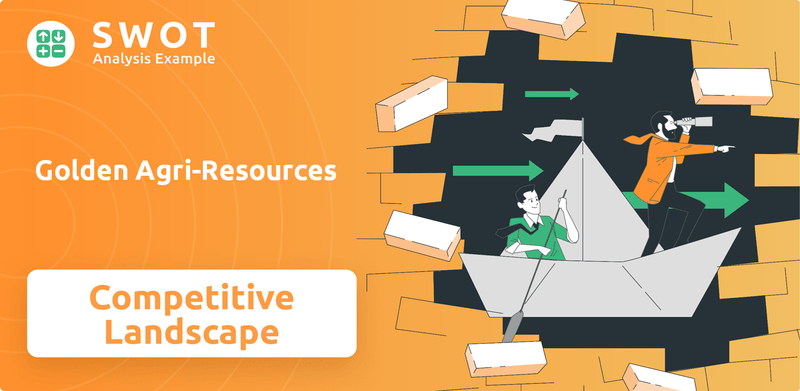
This exploration of the GAR market analysis will dissect its strategies and assess its standing against key rivals in Indonesia's palm oil sector. We'll examine GAR's financial performance review, competitive advantages, and sustainability practices to provide a comprehensive understanding of its operations. This analysis aims to equip you with actionable insights into GAR's position and potential investment opportunities within the palm oil industry.
Where Does Golden Agri-Resources’ Stand in the Current Market?
Golden Agri-Resources (GAR) has a strong market position in the global palm oil industry, supported by its extensive operations. As of late 2024, GAR manages approximately 535,000 hectares of palm oil plantations, including those of smallholders. This large-scale operation makes GAR a significant producer of crude palm oil (CPO) and palm kernel (PK).
GAR's core business involves the entire palm oil value chain, from fresh fruit bunches (FFB) and CPO to refined products like cooking oil, margarine, and specialty fats. This diversified product portfolio caters to both industrial and consumer markets worldwide. GAR's strategic focus on sustainable palm oil production, aiming for 100% certified sustainable palm oil (CSPO) by 2025, is a key differentiator, appealing to environmentally conscious consumers and businesses.
GAR's primary operations are located in Indonesia, where it benefits from favorable climate conditions and extensive land resources. Its downstream operations extend globally, serving customers in Asia, Europe, and North America. The company's integrated model provides resilience against CPO price volatility, as highlighted in its Q3 2024 financial report, which showed strong revenue figures across both upstream and downstream segments. For a deeper understanding of its financial structure, you can explore the Revenue Streams & Business Model of Golden Agri-Resources.
GAR consistently ranks among the top palm oil producers globally, often competing with major players in Indonesia and Malaysia. Its strong position in the Indonesian market is supported by its extensive land bank and established infrastructure. GAR's production capacity is a critical factor in its competitive landscape.
GAR's commitment to sustainable palm oil production, with a target of 100% CSPO by 2025, significantly impacts its market position. This focus on environmental and social governance (ESG) factors is increasingly important in the palm oil industry. This commitment helps GAR attract environmentally conscious consumers and businesses.
GAR's financial health is robust compared to industry averages, supported by its integrated business model. The company's Q3 2024 financial report showed strong revenue, reflecting the benefits of its diversified product portfolio and efficient operations. GAR's financial performance is a key indicator of its market strength.
GAR's primary geographic presence is in Indonesia, where most of its plantations and mills are located. Its downstream operations extend its reach to international markets, including Asia, Europe, and North America. This global presence helps GAR to maintain its market share and diversify its revenue streams.
GAR's competitive advantages include its large plantation area, integrated business model, and focus on sustainability. These factors contribute to its strong market position within the palm oil industry. GAR's integrated model allows it to manage costs and adapt to market changes more effectively.
- Large-scale plantation operations.
- Integrated value chain from upstream to downstream.
- Commitment to sustainable palm oil production.
- Strong financial performance and diversified revenue streams.
- Strategic geographic presence in key markets.
Golden Agri-Resources SWOT Analysis
- Complete SWOT Breakdown
- Fully Customizable
- Editable in Excel & Word
- Professional Formatting
- Investor-Ready Format
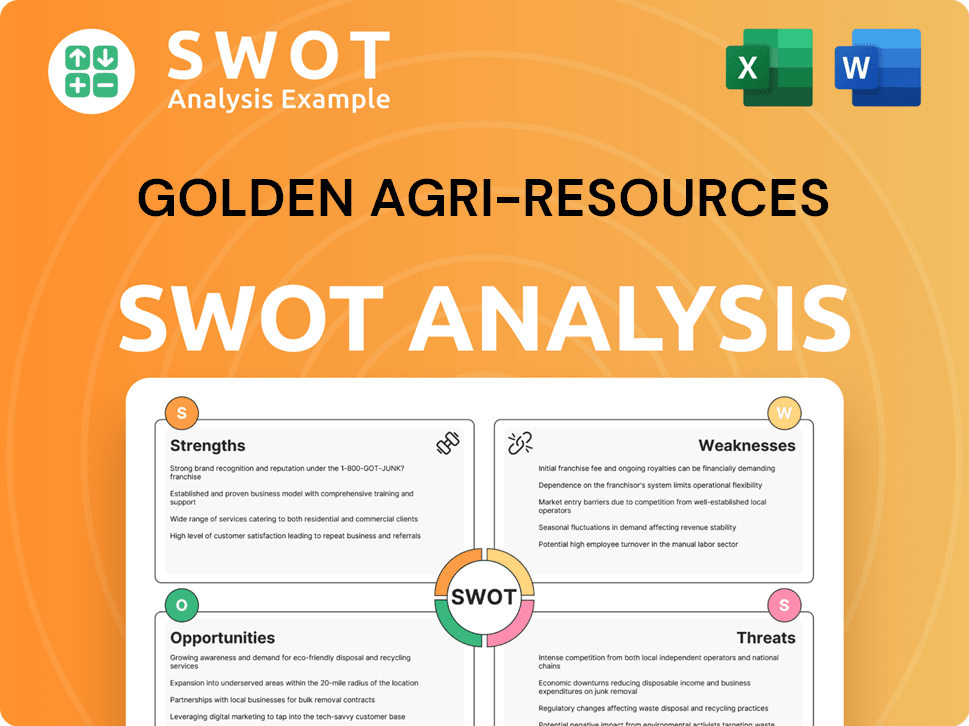
Who Are the Main Competitors Challenging Golden Agri-Resources?
The GAR competitive landscape is shaped by a complex interplay of major players in the palm oil industry, as well as indirect competition from producers of alternative vegetable oils. GAR market analysis reveals that the company faces challenges from both integrated agribusiness giants and specialized players. Understanding these competitive dynamics is crucial for assessing Golden Agri-Resources' strategic positioning and future growth prospects.
Indonesia's palm oil sector is dominated by a few large companies, and GAR is a significant player within this environment. The competitive pressure influences pricing, market share, and the adoption of sustainable practices. Recent trends, including increasing consumer awareness of environmental and social issues, are also reshaping the competitive dynamics.
GAR operates in a dynamic market, and its success depends on its ability to navigate the competitive environment effectively. For a deeper dive into their strategic approach, consider reading about the Growth Strategy of Golden Agri-Resources.
GAR's most direct competitors are primarily other large palm oil companies based in Indonesia and Malaysia. These competitors often have extensive operations, including plantations, refining, and distribution networks. They compete on factors such as production capacity, cost efficiency, and market access.
Wilmar International, a Singapore-based agribusiness giant, is a major competitor. It has a vast global refining and distribution network and a diversified product portfolio. Wilmar's strong presence in key consumer markets and its integrated operations make it a formidable rival.
Sime Darby Plantation Berhad from Malaysia is another key competitor, known for its extensive upstream operations and strong research and development. They are increasingly focused on sustainable practices.
IOI Corporation Berhad, also based in Malaysia, is a significant competitor. They are known for integrated operations and often compete on product innovation and market reach in niche segments.
Indirect competition comes from producers of alternative vegetable oils like soybean oil, rapeseed oil, and sunflower oil. Shifts in consumer preferences or trade policies can influence demand for these alternatives. The price competitiveness and versatility of palm oil are key factors.
Competition is intense in key importing regions like India and China. Sustainability certifications also play a crucial role. The competitive landscape is also being shaped by new players focusing on niche markets and those using advanced agricultural technologies. Mergers and alliances can shift market power.
Several factors drive competition within the palm oil industry. These include production costs, sustainability certifications, market access, and product innovation. GAR and its competitors continually strive to improve their performance in these areas to maintain or increase their market share.
- Production Costs: Efficiency in plantation management and refining processes.
- Sustainability: Compliance with and adoption of sustainable practices and certifications (e.g., RSPO).
- Market Access: Strong distribution networks and relationships with key customers, especially in India and China.
- Product Innovation: Development of value-added products and specialty fats.
Golden Agri-Resources PESTLE Analysis
- Covers All 6 PESTLE Categories
- No Research Needed – Save Hours of Work
- Built by Experts, Trusted by Consultants
- Instant Download, Ready to Use
- 100% Editable, Fully Customizable
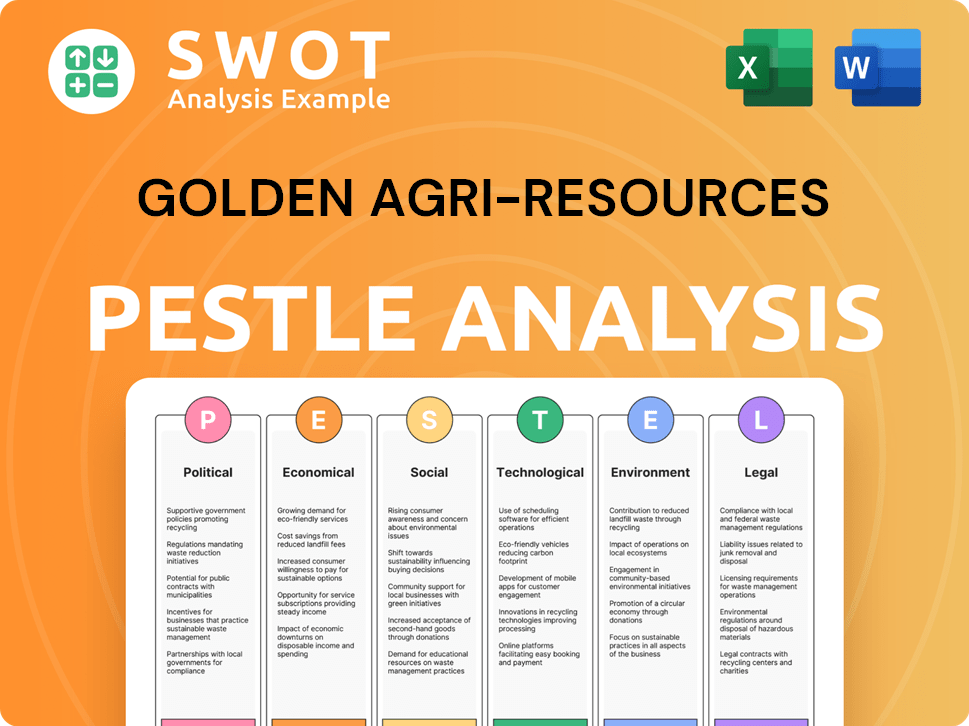
What Gives Golden Agri-Resources a Competitive Edge Over Its Rivals?
Golden Agri-Resources (GAR) carves out a significant position in the palm oil industry, leveraging several key competitive advantages. These advantages are crucial for understanding the Brief History of Golden Agri-Resources and its current standing. GAR's strengths help it navigate the complex agribusiness competition, particularly within Indonesia's palm oil sector.
GAR's strategic moves and operational efficiencies are designed to maintain its competitive edge. The company's focus on sustainability and integrated operations reflects a forward-thinking approach in a market increasingly concerned with environmental and social responsibility. These factors influence GAR's financial performance review and its ability to attract investment and secure market share.
The company's competitive landscape is shaped by its ability to manage costs, ensure product quality, and adhere to sustainable practices. GAR's approach to its business model supports its long-term growth strategies and its ability to impact palm oil prices. GAR's strategy is designed to withstand the challenges of the palm oil industry.
GAR benefits significantly from its vast land bank, which is approximately 535,000 hectares of oil palm plantations. This scale allows for lower per-unit production costs. GAR optimizes resource allocation and negotiates favorable terms with suppliers and buyers.
GAR manages the entire value chain from upstream cultivation to downstream processing. This integration provides greater control over product quality and supply chain efficiency. It enables GAR to capture more value across the supply chain, enhancing profitability.
GAR is committed to achieving 100% certified sustainable palm oil (CSPO) by 2025. The company's 'No Deforestation, No Peat, No Exploitation' (NDPE) policy positions it well with environmentally conscious customers. GAR's commitment enhances its brand equity and mitigates reputational risks.
GAR has established distribution networks, particularly in Asia. These networks ensure efficient delivery of its products to diverse markets. This advantage contributes to the company's ability to maintain market share and meet customer demands.
GAR's competitive advantages include its economies of scale, integrated agribusiness model, and sustainability initiatives. These advantages are supported by established distribution networks. These factors are key to understanding GAR's market position.
- Economies of Scale: Vast land bank and processing facilities.
- Integrated Model: Control over the entire value chain.
- Sustainability: Commitment to CSPO and NDPE policies.
- Distribution: Established networks, particularly in Asia.
Golden Agri-Resources Business Model Canvas
- Complete 9-Block Business Model Canvas
- Effortlessly Communicate Your Business Strategy
- Investor-Ready BMC Format
- 100% Editable and Customizable
- Clear and Structured Layout
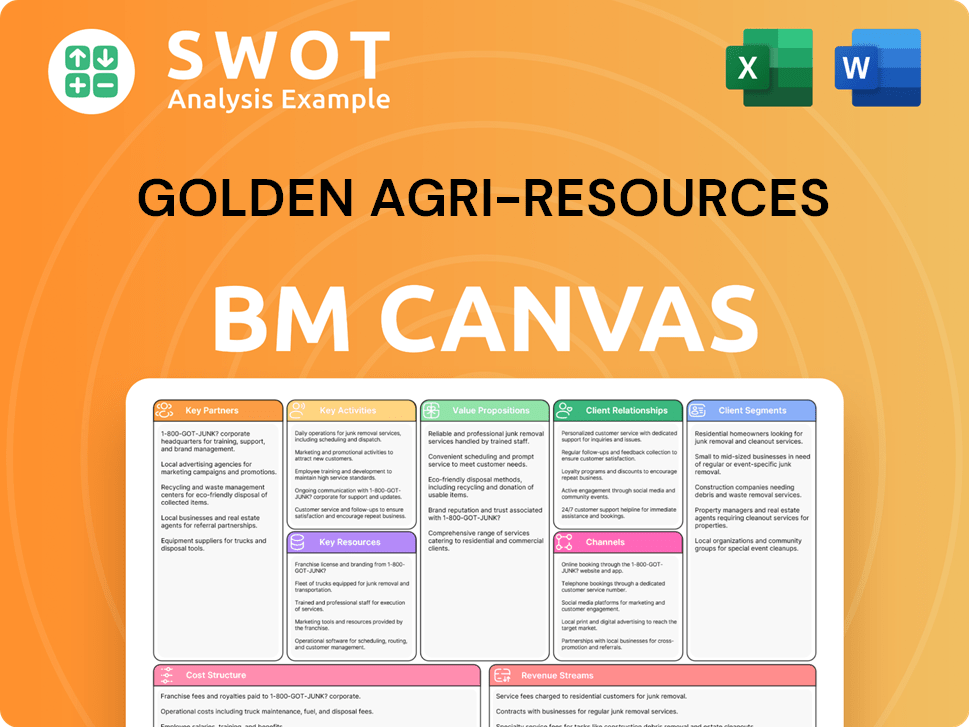
What Industry Trends Are Reshaping Golden Agri-Resources’s Competitive Landscape?
Analyzing the Golden Agri-Resources (GAR) competitive landscape involves understanding the dynamics of the palm oil industry, the strategies of key players, and the impact of sustainability and market trends. The industry is subject to fluctuating prices, environmental concerns, and evolving consumer preferences. A comprehensive GAR market analysis is crucial for investors, stakeholders, and competitors to assess its position and prospects.
Indonesia's palm oil sector, where GAR is a major player, faces challenges such as deforestation concerns and stringent regulations, especially from the EU. GAR's ability to adapt to these pressures and capitalize on growth opportunities will be critical. This includes its approach to sustainability, operational efficiency, and market diversification. To learn more about the company, you can also read about the Owners & Shareholders of Golden Agri-Resources.
The palm oil industry is seeing increased demand for sustainable practices. Consumer awareness, stricter regulations, and corporate commitments drive this trend. Technological advancements like precision agriculture and AI are enhancing yields and traceability. However, deforestation and greenhouse gas emissions continue to be significant concerns for the industry.
Navigating volatile crude palm oil (CPO) prices remains a key challenge, influenced by global supply and demand. Rising labor costs and potential land restrictions also pose operational challenges. Competition from alternative vegetable oils and new market entrants could erode market share. GAR must adapt to these pressures to maintain its market position.
Emerging markets in Asia and Africa offer significant growth potential due to population growth and rising incomes. Product innovation in oleochemicals and biofuels provides opportunities for diversification. Strategic partnerships with global food and consumer goods companies can secure long-term contracts and facilitate market expansion. GAR can leverage its integrated model.
GAR's strategies include enhancing operational efficiency, expanding sustainable certifications, and investing in R&D for higher-yielding seeds. Exploring new market segments for palm-based products is also a key focus. The company aims for 100% certified sustainable palm oil (CSPO) by 2025, highlighting its commitment to sustainability.
Several factors influence the GAR competitive landscape and its future prospects. These include sustainability initiatives, technological adoption, and market dynamics. Analyzing these factors helps in understanding GAR's position relative to competitors like Wilmar International and other players in the agribusiness competition.
- Sustainability: GAR's commitment to CSPO certification and NDPE (No Deforestation, No Peat, No Exploitation) policies are crucial in meeting consumer and regulatory demands.
- Technology: Adoption of precision agriculture and AI can improve yields and efficiency, enhancing GAR's competitive edge.
- Market Dynamics: Volatile CPO prices, emerging markets, and product innovation opportunities shape the industry's future.
- Financial Performance: GAR's financial performance review, influenced by CPO prices and operational efficiency, is key to assessing its long-term viability.
Golden Agri-Resources Porter's Five Forces Analysis
- Covers All 5 Competitive Forces in Detail
- Structured for Consultants, Students, and Founders
- 100% Editable in Microsoft Word & Excel
- Instant Digital Download – Use Immediately
- Compatible with Mac & PC – Fully Unlocked
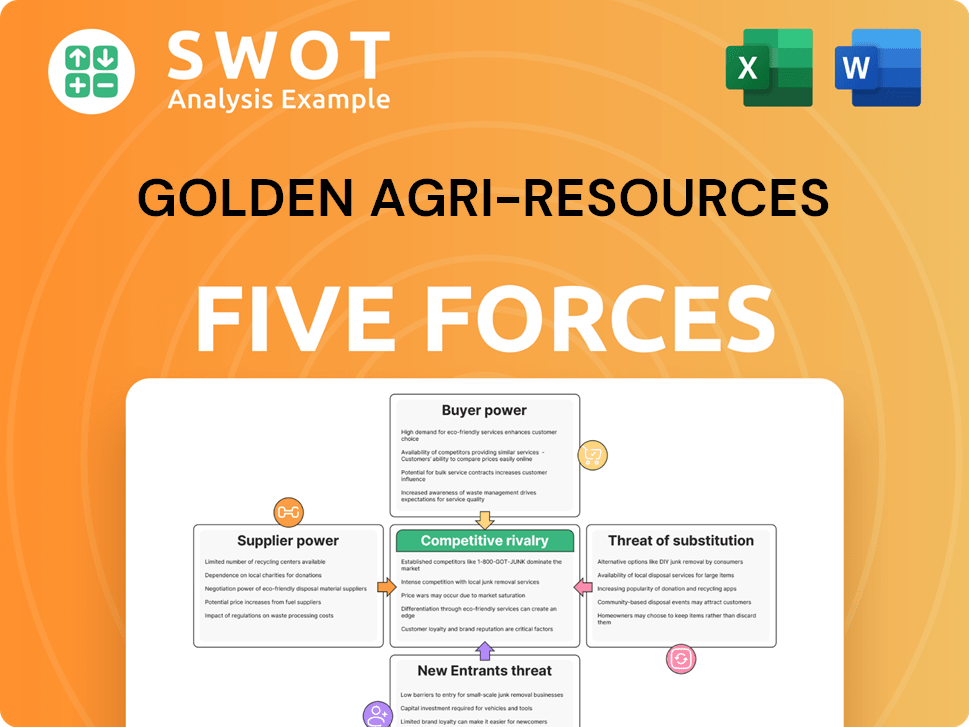
Related Blogs
- What are Mission Vision & Core Values of Golden Agri-Resources Company?
- What is Growth Strategy and Future Prospects of Golden Agri-Resources Company?
- How Does Golden Agri-Resources Company Work?
- What is Sales and Marketing Strategy of Golden Agri-Resources Company?
- What is Brief History of Golden Agri-Resources Company?
- Who Owns Golden Agri-Resources Company?
- What is Customer Demographics and Target Market of Golden Agri-Resources Company?
Disclaimer
All information, articles, and product details provided on this website are for general informational and educational purposes only. We do not claim any ownership over, nor do we intend to infringe upon, any trademarks, copyrights, logos, brand names, or other intellectual property mentioned or depicted on this site. Such intellectual property remains the property of its respective owners, and any references here are made solely for identification or informational purposes, without implying any affiliation, endorsement, or partnership.
We make no representations or warranties, express or implied, regarding the accuracy, completeness, or suitability of any content or products presented. Nothing on this website should be construed as legal, tax, investment, financial, medical, or other professional advice. In addition, no part of this site—including articles or product references—constitutes a solicitation, recommendation, endorsement, advertisement, or offer to buy or sell any securities, franchises, or other financial instruments, particularly in jurisdictions where such activity would be unlawful.
All content is of a general nature and may not address the specific circumstances of any individual or entity. It is not a substitute for professional advice or services. Any actions you take based on the information provided here are strictly at your own risk. You accept full responsibility for any decisions or outcomes arising from your use of this website and agree to release us from any liability in connection with your use of, or reliance upon, the content or products found herein.